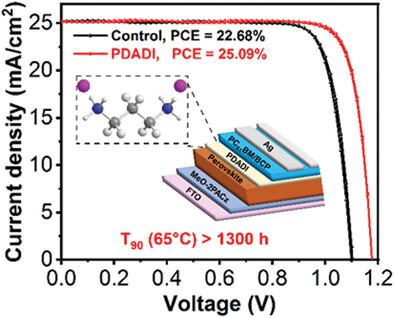当前位置:
X-MOL 学术
›
Adv. Funct. Mater.
›
论文详情
Our official English website, www.x-mol.net, welcomes your
feedback! (Note: you will need to create a separate account there.)
Surface Passivation with Diaminopropane Dihydroiodide for p-i-n Perovskite Solar Cells with Over 25% Efficiency
Advanced Functional Materials ( IF 18.5 ) Pub Date : 2023-12-08 , DOI: 10.1002/adfm.202312426
Zhong‐Rui Lan 1, 2 , Yu‐Duan Wang 1, 3 , Jiang‐Yang Shao 1 , Dian‐Xue Ma 1, 2 , Zhenghao Liu 4 , Dongmei Li 4 , Yi Hou 3 , Jiannian Yao 1, 2 , Yu‐Wu Zhong 1, 2
Advanced Functional Materials ( IF 18.5 ) Pub Date : 2023-12-08 , DOI: 10.1002/adfm.202312426
Zhong‐Rui Lan 1, 2 , Yu‐Duan Wang 1, 3 , Jiang‐Yang Shao 1 , Dian‐Xue Ma 1, 2 , Zhenghao Liu 4 , Dongmei Li 4 , Yi Hou 3 , Jiannian Yao 1, 2 , Yu‐Wu Zhong 1, 2
Affiliation

|
At present, one of the major factors limiting the further improvement of inverted (p-i-n) perovskite solar cells (PSCs) is trap-assisted non-radiative recombination at the perovskite/electron transporting layer (ETL) interface. Surface passivation with organic ammonium salt is a powerful strategy to improve the performance of PSCs. Herein, an effective method by using propylamine hydroiodide (PAI) and 1,3-diaminopropane dihydroiodide (PDADI) is reported to modify the perovskite/ETL interface. These two ammonium salts do not form new perovskite but directly passivate the defects on the perovskite surface after annealing. The results show that the PDADI-modified perovskite films possess a lower surface defect density and less non-radiative recombination as well as improved charge carrier transport. Based on this strategy, the PDADI-modified p-i-n PSCs deliver an impressive efficiency of 25.09% (certified 24.58%) with an open-circuit voltage of 1.184 V. Furthermore, the unencapsulated PDADI-modified PSCs also exhibit good storage stability, retaining 91% of initial PCE at 65 °C in a N2 glove box for 1300 h. This strategy provides an efficient route to fabricate highly efficient and stable inverted p-i-n structured PSCs.
中文翻译:

使用二氢碘化二氨基丙烷进行表面钝化,用于针式钙钛矿太阳能电池,效率超过 25%
目前,限制倒置(pin)钙钛矿太阳能电池(PSC)进一步改进的主要因素之一是钙钛矿/电子传输层(ETL)界面处的陷阱辅助非辐射复合。用有机铵盐进行表面钝化是提高PSC性能的有效策略。在此,报道了一种使用丙胺氢碘化物(PAI)和1,3-二氨基丙烷二氢碘化物(PDADI)来修饰钙钛矿/ETL界面的有效方法。这两种铵盐在退火后不会形成新的钙钛矿,而是直接钝化钙钛矿表面的缺陷。结果表明,PDADI 修饰的钙钛矿薄膜具有较低的表面缺陷密度和较少的非辐射复合以及改善的载流子传输。基于这一策略,PDADI 改进的引脚 PSC 具有 25.09% 的令人印象深刻的效率(认证为 24.58%),开路电压为 1.184 V。此外,未封装的 PDADI 改进的 PSC 还表现出良好的存储稳定性,保留了 91%初始 PCE 在 65 °C 下在 N 2手套箱中持续 1300 小时。该策略为制造高效且稳定的倒置引脚结构 PSC 提供了一条有效的途径。
更新日期:2023-12-08
中文翻译:

使用二氢碘化二氨基丙烷进行表面钝化,用于针式钙钛矿太阳能电池,效率超过 25%
目前,限制倒置(pin)钙钛矿太阳能电池(PSC)进一步改进的主要因素之一是钙钛矿/电子传输层(ETL)界面处的陷阱辅助非辐射复合。用有机铵盐进行表面钝化是提高PSC性能的有效策略。在此,报道了一种使用丙胺氢碘化物(PAI)和1,3-二氨基丙烷二氢碘化物(PDADI)来修饰钙钛矿/ETL界面的有效方法。这两种铵盐在退火后不会形成新的钙钛矿,而是直接钝化钙钛矿表面的缺陷。结果表明,PDADI 修饰的钙钛矿薄膜具有较低的表面缺陷密度和较少的非辐射复合以及改善的载流子传输。基于这一策略,PDADI 改进的引脚 PSC 具有 25.09% 的令人印象深刻的效率(认证为 24.58%),开路电压为 1.184 V。此外,未封装的 PDADI 改进的 PSC 还表现出良好的存储稳定性,保留了 91%初始 PCE 在 65 °C 下在 N 2手套箱中持续 1300 小时。该策略为制造高效且稳定的倒置引脚结构 PSC 提供了一条有效的途径。

































 京公网安备 11010802027423号
京公网安备 11010802027423号